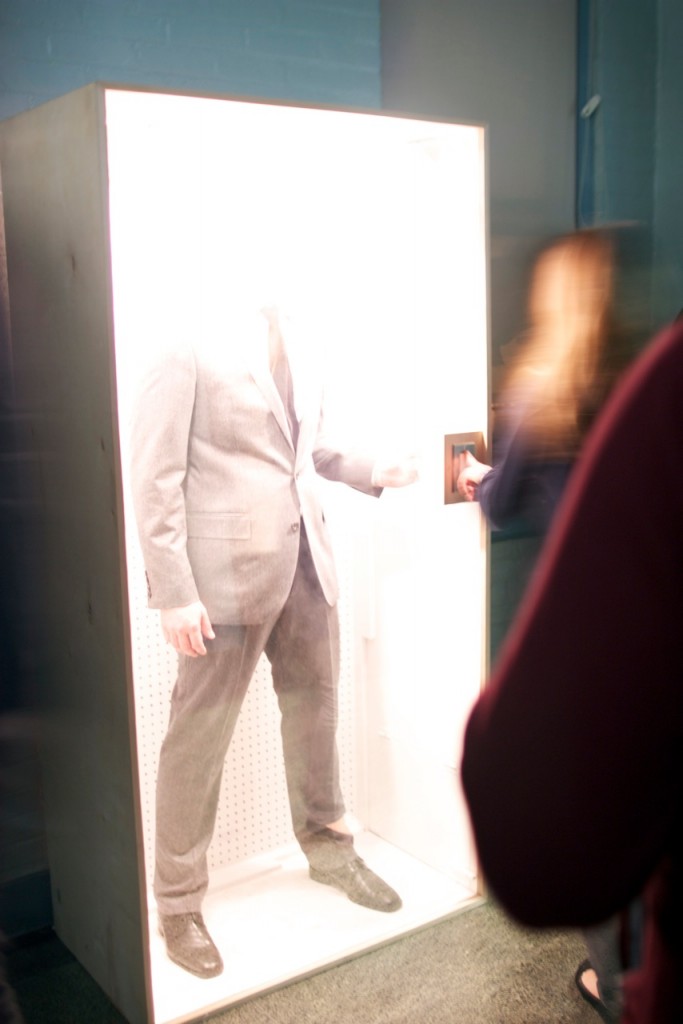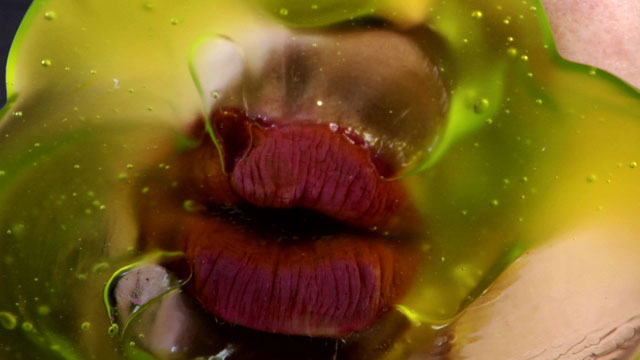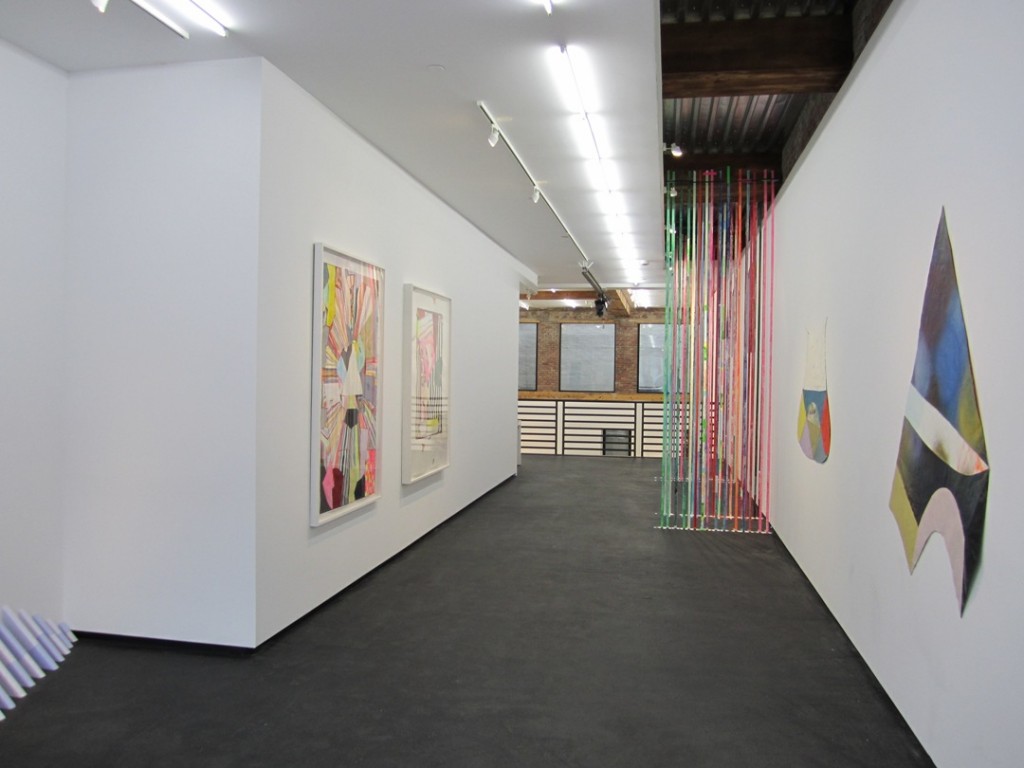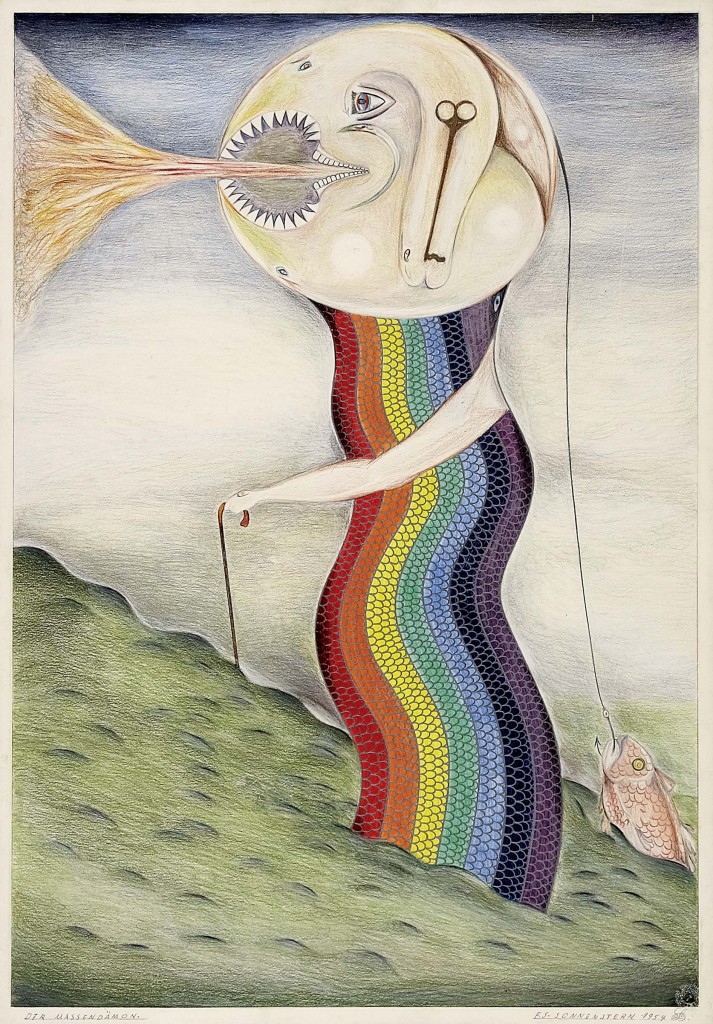by Amanda Schmitt
on July 3rd, 2012
June 26, 2012 New York, New York
Inspired by an Oliver Sacks lecture on hallucinations and perception, Molly Surno brought four delightfully abstract films to her ongoing experimental film series, Cinema 16, at the Kitchen on this Tuesday evening, leaving an entire theater-full of guests bug-eyed and awe-jawed. To add to the experience, she invited musician and composer Matteah Baim to imagine an original soundtrack for the screening, adding another dimension of emotionality to the atmosphere, and creating an unlikely collaboration between artists who will never meet. The works span over the course of almost an entire century, from 1924 to 2010, all running on a 16-mm projector (Bravo Kitchen!). Continue Reading More »
Comments closed
by Amanda Schmitt
on October 24th, 2011

Oliver Warden, Untitled Box 2.0, 1993-2011. Photo credit: Josephine Phong, 2011.
A young woman rounds the corner and catches a glimpse of her reflection in a full-length mirrored box. Attracted to this, she stops to make sure her bangs are okay, and notices that the mirror also has a switch, at perfect doorbell height. Curious, she flips the switch, only to immediately jump back, letting out a half scream, half laugh. She might be going crazy, she thinks, but she swears she just saw her reflection change into that of a man’s. Intrigued, she presses the switch a second time, and registers the flashing image of him again. Sure enough, inside the two-way mirror is a man, about 6’, standing at the ready, in a grey suit with a black tie. He has the appearance of James Bond, but the moxy of Elvis Presley vis-à-vis Andy Warhol’s prints. This man also has an identically placed switch on his side of the mirror. While the young woman can turn on the light, revealing the man, he has the power to turn the light off. The young woman giggles, fascinated by her power, yet she still feels the need to touch the switch again, and sees the opportunity to compete; a game ensues. She continuously turns on the light, as fast as she can, trying to reveal the man, to find out who he is, and what he looks like. He is calm and quick to the switch; she is relentless. She giggles more and more, and he remains stone cold 007, intensely staring into her eyes. You can see he is sweating, somewhat annoyed yet maintaining his authority, which fuels this woman’s sadistic tendencies even more. Who will win? Continue Reading More »
Comments closed
by Amanda Schmitt
on August 2nd, 2011

Marilyn Minter, Green Pink Caviar, video, 8:00, 2009, courtesy of Ramis Barquet Gallery
If you find yourself trekking under the hot sun and making the gallery rounds in Chelsea on a 98°F day in the middle of July, then you are surely a glutton for punishment. However, thanks to the cool respite of air conditioning in Ramis Barquet Gallery, one can comfortably experience another sort of “Glutton for Punishment,” as this annual group video exhibition is aptly titled. Rather than a traditional video screening with a seated, theater arrangement, curator Nicholas Kilner presents each of the five videos separately, realizing a unique exhibition format and creating an immersive video experience. As the press release perfectly describes, “each of the works included uses video as a platform to explore the body in all its physicality and its subjectivity to innocent and aggressive desire.” Continue Reading More »
Comments closed
by Amanda Schmitt
on July 14th, 2011

Installation, Can I Get a Witness, 2011
Joshua Abelow set out to create a personal, visual archive through his blog, “ART BLOG ART BLOG,” but within a year he was getting up to 900 hits a day from over 125 countries. Less than two years later, the blog has materialized into a physical, artist-run gallery space, ART BLOG ART BLOG, with nine independently curated exhibitions, open through October 29, in a donated space located in Chelsea at 508 West 26th St, Floor 11.
“ART BLOG ART BLOG” (the blog) emerged in early 2010 as an important way for Abelow to build a community over the web and engage with artists in other cities. Now back in New York, Abelow maintains his blog as a diaristic visual journal, with daily posts including other artists’ work, book and album covers, posters, personal work and photographs, poems and quips, and more. I had a chance to sit down with Abelow, and the curators of the upcoming exhibition, “Can I Get a Witness?” to find out more about the project. Continue Reading More »
Comments closed
by Amanda Schmitt
on June 11th, 2011

Roof Piece
Yesterday evening, ten dancers of the Trisha Brown Dance Company, quietly emerged after a summer downpour and scattered themselves across the rooftops of the West Village to perform “Roof Piece.” The dancers will re-emerge to re-perform tonight, rain or shine, best and most accessibly viewed on the south section of the High Line (south of 13th Street). On the 40th anniversary of its creation, this choreography of this version is new and original based on the improvisational quality of the work itself. High up and far away, one dancer, facing south, begins the movement. Another dancer further north, mimics the movement of another dancer in view, yet slightly delayed, and adapted to their own body and style. This chain of dancers continues north and crosses through the High Line, creating a sort of spiral. Half the fun of viewing this performance is filling in the puzzle pieces, searching for spots of red, playing a game of “Where’s Waldo” for the ten dancers (I could only find seven, but perhaps you’ll find more). “Roof Piece” literally surrounds the viewer, the High Line, and the entire neighborhood. This performance is a must see!
Performances will take place Friday, June 10 at 7pm, and Saturday, June 11 at 5pm and 7pm.
Comments closed
by Amanda Schmitt
on April 4th, 2011

The Thingness of Color, installation, 2011, Dodge Gallery, New York, NY
We’ve made it through the winter, and on a warm spring day I let my gallery-legs thaw and took a stroll to see what LES had in store for me. I am happy to have wandered into a new space that I have noticed before, but looks like it will be a mainstay on Rivington, along with its neighbors, ElevenRivington and Thierry Goldberg. In a large, open space that was formerly a sausage factory, Dodge Gallery opened in September 2010 with a group show, Dramatus Personae, a group show that –aptly titled– presented the gallery’s roster of artists. Their sixth exhibition opens this Saturday with a solo show by Sheila Gallagher downstairs and a group show, The Thingness of Color, upstairs.
Continuing our Featured Gallery series, I was able to ask Founder/Director Kristen Dodge about the past, present and future of the gallery.
As a young gallery, you have already developed an impressive and intriguing roster. What was Dodge Gallery before you had a space on Rivington?
I’ve always known that I would open my own business and in fact, decided that it would be an art gallery before ever working at one. There’s something about the combination of business and art that was extremely appealing to me- addressing the two sides of my brain. But it wasn’t until I spent several years working under the guidance of Abigail Ross and eventually growing into the position of Director and establishing a creative partnership with her at the rotenberg gallery in Boston, when I realized that running a gallery is not only something I want to do, but it’s something I can do. I remember asking Sina Najafi at Cabinet Magazine, my first employer out of college, why he decided to start his own business and he said, “because I don’t want to work for anyone else.” I eventually landed in that same place and became my own boss. Continue Reading More »
Comments closed
by Amanda Schmitt
on March 28th, 2011

Courtesy Michael Werner Gallery (New York and Berlin)
An exhibition of twenty-eight truly incredible, even mind-boggling, drawings by an obscure outsider artist was hardly what I expected to find in the parquet-floored galleries of the Upper East Side. First of all, I must preface that I abhor the term “outsider art,” but Schroder-Sönnenstern certainly was never in the ‘front line’ of his contemporaries, and after a little research, I came to learn that he was socially obscure and ostracized. This is visible in his drawings on view (all pencil and colored pencil on cardboard), which are strange and fantastical. As Jean Dubuffet would describe Art Brut (or Outsider Art), these drawings were created from “unselfconscious imagery born of pure, uninhibited expression.” Continue Reading More »
Comments closed







 RSS
RSS
